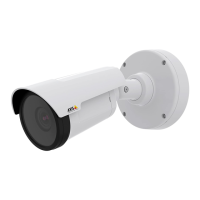
Do you have a question about the Axis P1428–E and is the answer not in the manual?
| Type | IP security camera |
|---|---|
| PTZ control | Yes |
| Placement supported | Outdoor |
| Connectivity technology | Wired |
| Form factor | Bullet |
| Product color | White |
| Total megapixels | 8.3 MP |
| Maximum resolution | 3840 x 2160 pixels |
| Supported video modes | - |
| Angle of rotation | 180 ° |
| Camera shutter speed | 1/28000 - 2 s |
| Minimum illumination | 1.4 lx |
| Sensor type | CMOS |
| Optical sensor size | 1/2.5 \ |
| Optical zoom | 3 x |
| Built-in HDD | No |
| Compatible memory cards | MicroSDHC |
| Maximum memory card size | 64 GB |
| Cabling technology | 10/100Base-T(X) |
| Supported network protocols | Pv4/v6, HTTP, HTTPS, SSL/TLS, QoS Layer 3, DiffServ, FTP, CIFS/SMB, SMTP, Bonjour, UPnP, SNMPv1/v2c/v3 (MIB-II), DNS, DynDNS, NTP, RTSP, RTP, TCP, UDP, IGMP, RT, CP, ICMP, DHCP, ARP, SOCKS |
| Interface | RJ-45 |
| Ethernet LAN (RJ-45) ports | 1 |
| Power source type | PoE |
| Power consumption (typical) | 12.9 W |
| Operating temperature (T-T) | -30 - 50 °C |
| Operating relative humidity (H-H) | 10 - 100 % |
| Weight | 854 g |
|---|
Equipment tested for radio frequency emission and immunity standards.
Covers general safety, warnings, and battery handling.
Instructions for proper disposal and recycling of the product.
Details about physical ports, buttons, and indicators on the camera.
Instructions for accessing the product via browser and internet.
Steps to set the initial administrator password for secure access.
Configuring H.264 and Motion JPEG video stream settings.
Essential initial settings before using the product.
Detailed settings for video streams, including resolution and compression.
Adjusting image quality, white balance, and exposure controls.
Creating specific regions of interest within the camera's view.
Setting privacy masks and adjusting camera focus and zoom.
Customizing viewer toolbar and features for video playback.
Managing saved camera positions and automated patrol sequences.
Setting up alarms for tampering and motion detection events.
Installing third-party applications and managing their licenses.
Defining conditions and actions for event-driven responses.
Overview of various triggers like detectors, hardware, and system events.
Performing actions like recording, sending notifications, and defining recipients.
Defining time-based schedules and periodic triggers for action rules.
Accessing recorded files and configuring continuous video recording.
Procedures for uploading and selecting different language options.
Managing user access, IP filtering, and HTTPS for secure operation.
Configuring network access control and managing digital certificates.
Synchronizing product time and configuring basic IP settings.
Configuring IP addresses using DHCP, static methods, or ARP/Ping.
Using AVHS for remote access and configuring DNS servers.
Configuring time sync, host names, and NAT traversal for external access.
Managing local SD card storage and network shares (NAS).
Performing product maintenance and accessing support information.
Reviewing product status, settings, and generating logs for troubleshooting.
Accessing advanced settings and resetting the product to factory defaults.
Procedures for upgrading firmware and recovering from failed upgrades.
Resolving IP address conflicts and browser login issues.
Addressing problems with H.264 stream performance and image quality.
Handling storage disruption alarms and troubleshooting SD card recording.
Detailed technical specifications for camera, video, network, and integration.
Pin assignments and specifications for the I/O terminal block.
Understanding how settings impact bandwidth, frame rate, and CPU load.